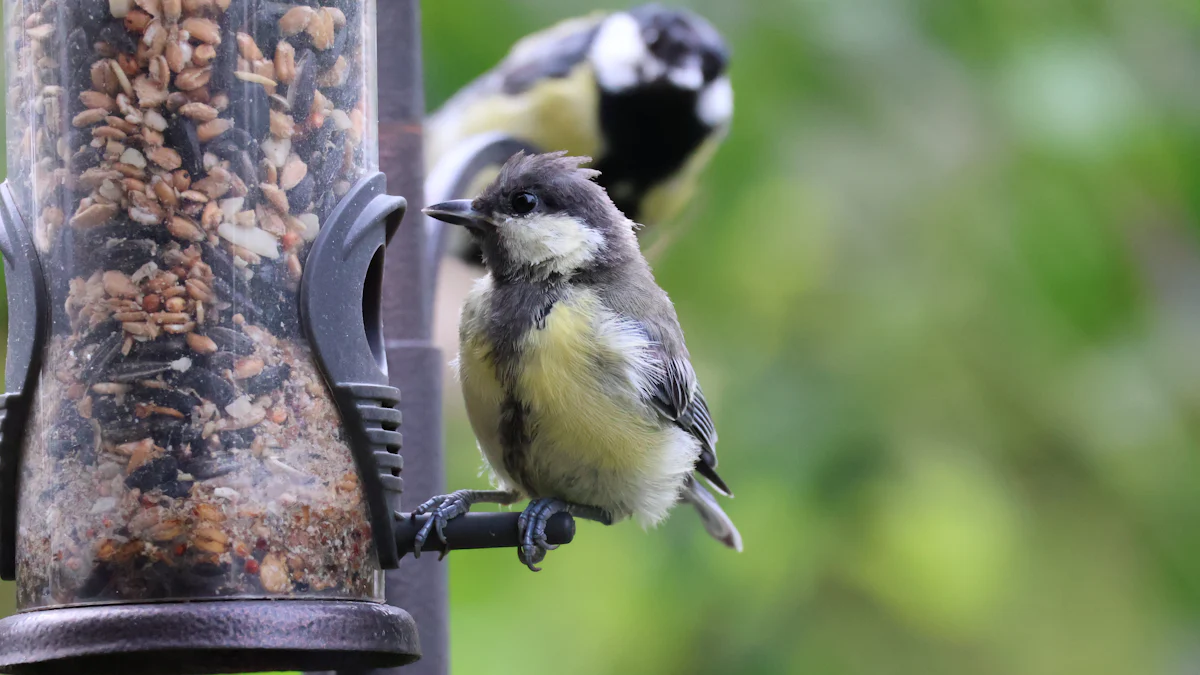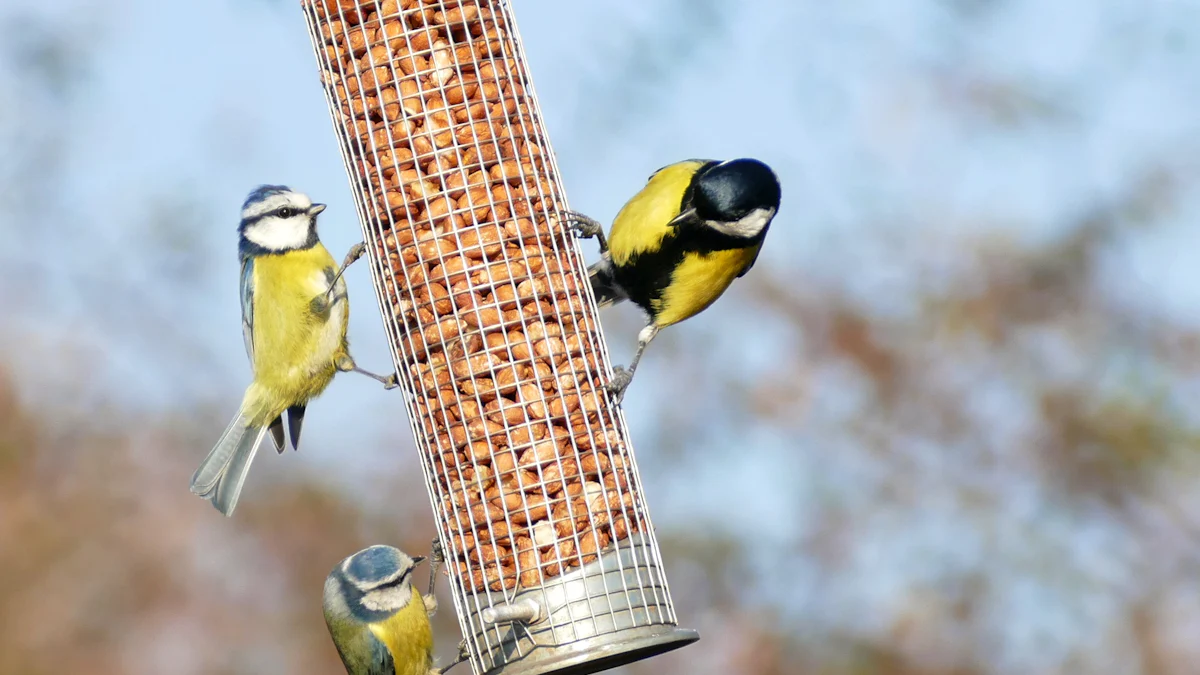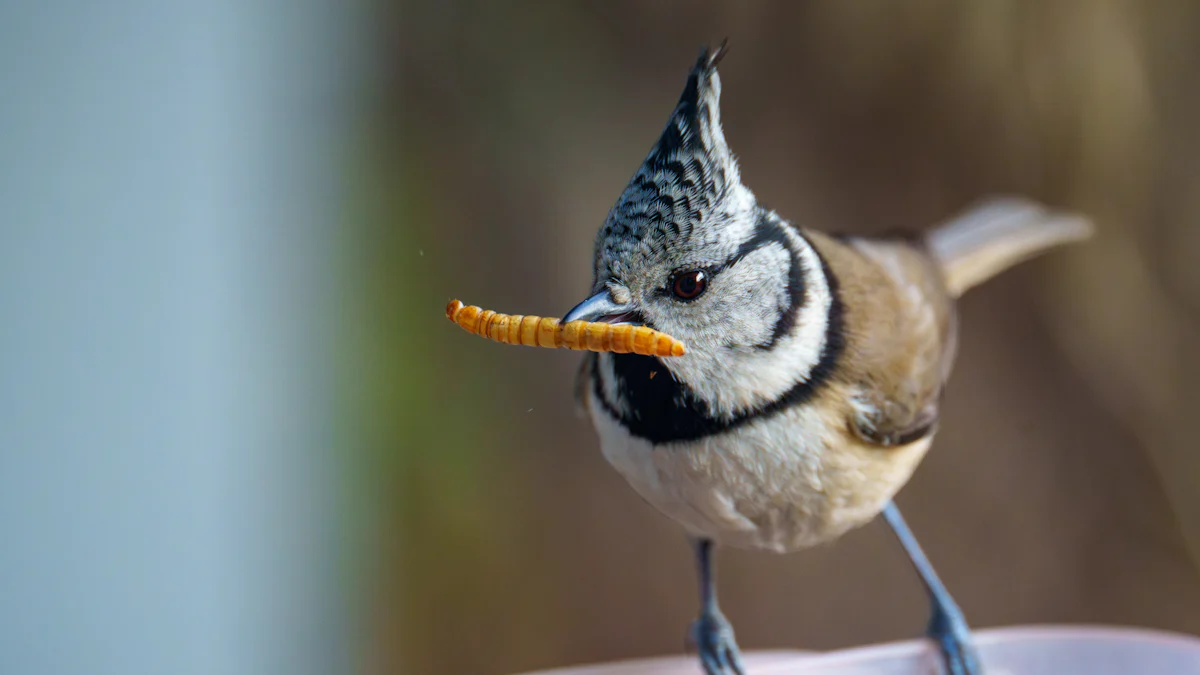
Feeding dried mealworms for birds is a simple way to boost their health. These tiny treats are packed with protein (about 50%) and fat (around 30%), giving birds the energy they need. Plus, they’re rich in vitamin B, which helps birds like bluebirds during breeding season. Try dried mealworms for birds to attract vibrant, healthy birds!
Key Takeaways
- Dried mealworms are healthy snacks for birds. They have 50% protein and 30% fat, which give birds energy and keep them strong.
- Start by giving mealworms slowly, just once or twice a week. Soaking them in water can make birds like them more.
- Pick the right feeder. Use tray feeders for all birds, mesh feeders for small birds, and ground feeders for bigger birds. This helps attract different kinds of birds.
Why Dried Mealworms for Birds Are a Great Choice

Nutritional Benefits of Dried Mealworms
Dried mealworms are like a superfood for birds. They’re packed with protein—about 50%—which helps young birds grow strong and supports muscle development. They also contain healthy fats, around 30%, which give birds the energy they need to stay active. Plus, they’re loaded with essential vitamins and minerals, like vitamin B, that boost energy metabolism and keep birds thriving.
Here’s a quick breakdown of what makes dried mealworms so nutritious:
- High in protein, perfect for growth and energy.
- Rich in fats, promoting vitality and shiny feathers.
- Full of vitamins and minerals that support overall health.
Compared to other bird feed options, dried mealworms stand out. Check out this comparison:
| Feed Type | Crude Protein | Crude Fat |
|---|---|---|
| Dried Mealworms | 50% – 55% | 24% – 25% |
| Live Mealworms | 20% | 13% |
| Other Common Bird Feeds | Varies | Varies |
How They Support Bird Health and Energy
Birds need a lot of energy to fly, forage, and care for their young. Dried mealworms provide the perfect fuel. Their high protein content helps birds build and repair muscles, especially during the breeding season. The fats in mealworms act as a quick energy source, keeping birds active throughout the day. Vitamins like vitamin B play a key role in energy metabolism, ensuring birds can make the most of their food.
By adding dried mealworms to your bird feeder, you’re giving birds the nutrients they need to thrive. It’s a simple way to support their health and energy levels.
Why Birds Are Naturally Attracted to Mealworms
Birds love mealworms, and it’s easy to see why. These little treats are packed with fiber, protein, and fat, making them a nutritious snack. During nesting and egg-laying seasons, birds instinctively seek out foods like mealworms to give them the extra energy they need. Mealworms also attract a variety of insect-eating birds, like bluebirds and robins, to your yard.
Another reason birds flock to mealworms? They’re clean and easy to eat. Unlike live insects, dried mealworms don’t squirm or make a mess, making them a convenient choice for both you and the birds.
How Often to Feed Dried Mealworms to Birds
Recommended Feeding Frequency
You might wonder how often to offer dried mealworms to your feathered visitors. Birds don’t need mealworms every day, but they’ll appreciate them as an occasional treat. Start by offering small amounts once or twice a week. This keeps the birds interested without overfeeding them. If you’re introducing dried mealworms for the first time, don’t worry if they’re not immediately popular. Birds sometimes take time to adjust to new foods.
To make dried mealworms more enticing, try moistening them with lukewarm water. This softens the texture and mimics live mealworms, which many birds prefer. However, avoid leaving damp mealworms out for more than a day or two to prevent spoilage.
Seasonal Feeding Tips
Birds’ feeding habits change with the seasons. During spring and summer, when natural food sources are abundant, you might notice birds ignoring dried mealworms. In these cases, offering live mealworms first can grab their attention. Once they’re familiar with your feeder, you can switch back to dried mealworms.
In the nesting season, birds need extra energy and hydration. Live mealworms are ideal during this time, but soaked dried mealworms can also help. During extreme weather, like heatwaves, birds benefit from the added moisture in soaked mealworms. These small adjustments can make a big difference in supporting your local bird population.
Making Dried Mealworms More Appealing
If you’re struggling to attract birds to dried mealworms, don’t give up! Soaking them in lukewarm water is a simple trick that works wonders. The softened texture and added moisture make them more appealing. Another method is to briefly offer live mealworms to catch the birds’ attention. Once they’re hooked, you can transition back to dried mealworms.
Remember, patience is key. Birds like bluebirds and Carolina wrens may prefer live mealworms initially, but they’ll warm up to dried ones over time. By experimenting with these tips, you’ll soon have a yard full of happy, well-fed birds.
Best Feeders for Dried Mealworms

Tray Feeders for Versatility
Tray feeders are a fantastic option if you’re looking for flexibility. These feeders are simple, flat platforms that allow you to offer dried mealworms for birds alongside other treats like seeds or fruit. Birds of all sizes can easily perch on them, making tray feeders a great choice for attracting a variety of species. You can place them on a pole, hang them, or even set them on the ground. Just make sure to clean the tray regularly to keep it fresh and inviting for your feathered visitors.
Mesh Feeders for Small Birds
If you want to cater to smaller birds, mesh feeders are the way to go. These feeders have small openings that make it easy for tiny birds to grab a mealworm while keeping larger birds at bay. You’ll likely see bluebirds, chickadees, thrushes, titmice, wrens, nuthatches, and even kinglets enjoying the feast. Mesh feeders are also great for keeping the dried mealworms secure, so they don’t blow away in the wind. Hang one in a quiet spot, and watch as small birds flock to it.
Ground Feeders for Larger Birds
Larger birds like robins and blackbirds prefer feeding on the ground. Ground feeders are perfect for these species, as they mimic the natural way these birds forage. You can scatter dried mealworms directly on the ground or use a low platform feeder. Just be mindful of potential pests and predators. Placing the feeder in an open area with good visibility can help keep the birds safe while they enjoy their meal.
Storing Dried Mealworms Properly
Keeping dried mealworms fresh and safe is easier than you might think. With the right storage practices, you can maintain their quality and ensure they stay nutritious for your feathered friends.
Tips for Long-Term Storage
To store dried mealworms for the long haul, focus on keeping them in a cool, dry place. A temperature range of 60°F to 75°F (15°C to 24°C) works best. Avoid direct sunlight, as it can degrade their quality. If you have extra mealworms, freezing them in airtight containers at temperatures below -15°C can keep them fresh for over six months. For even longer storage, consider drying them further or turning them into powder.
Here are some quick tips to follow:
- Use containers with ventilation holes to allow airflow and prevent condensation.
- Store mealworms in a dark, dry spot to avoid mold growth.
- Regularly check for contamination, like mites or mold, to keep them clean.
By following these steps, you’ll have a steady supply of high-quality mealworms ready for your backyard birds.
Preventing Moisture and Pests
Moisture and pests are the biggest threats to dried mealworms. To keep them safe, monitor the humidity and temperature inside their container. A thermometer and hygrometer can help you track these levels. If you notice excess moisture, place a paper towel over the mealworms or add more dry food to absorb it.
Here’s a simple routine to prevent issues:
- Clean the storage container every two weeks to stop mold or bacteria.
- Use airtight containers or resealable plastic bags to block pests.
- Freeze surplus mealworms if you’re not using them right away.
These steps will help you avoid spoilage and keep pests from ruining your bird treats.
Recognizing Spoiled Mealworms
It’s important to know when mealworms have gone bad. Spoiled mealworms often have an off smell, discoloration, or visible mold. If you notice any of these signs, it’s time to toss them out. Feeding spoiled mealworms to birds can harm their health, so always inspect them before use.
When in doubt, trust your senses. A fresh batch of dried mealworms should look golden-brown and smell neutral. By staying vigilant, you’ll ensure your birds get only the best.
Where to Buy High-Quality Dried Mealworms for Birds
Local Stores and Garden Centers
Shopping locally for dried mealworms has its perks. You can inspect the mealworms before buying, ensuring they’re fresh and of good quality. Many garden centers and pet shops stock mealworms, and by purchasing from them, you’re supporting your local economy. Plus, some garden centers sell mealworms for composting, which can enrich your soil and promote sustainable gardening practices.
Here’s why buying locally is a great choice:
- You can see the product firsthand to check for freshness.
- Supporting local businesses helps your community thrive.
- Some stores offer mealworms for gardening, which can improve soil health.
If you’re unsure where to start, check out your nearest farmer’s market or pet store. You might be surprised by the variety they offer!
Online Retailers and Bulk Purchases
Buying dried mealworms online is incredibly convenient. Many retailers offer a range of quantities, so you can choose what fits your needs. Whether you’re feeding a few birds or a whole flock, there’s an option for you. Reading reviews and checking seller ratings can help you find reliable suppliers. Plus, online shopping makes it easy to compare prices and snag the best deals.
Here are some benefits of buying online:
- Access to a wide variety of options and quantities.
- The ability to read reviews and ensure seller reliability.
- Bulk purchases often save money in the long run.
If you’re feeding birds regularly, consider buying in bulk. It’s cost-effective and ensures you always have a supply on hand.
Choosing the Best Quality Mealworms
When selecting dried mealworms, quality matters. Look for mealworms with a golden-brown color and a neutral smell. Avoid any that appear moldy or discolored. High-quality mealworms are rich in protein (around 50%) and fat (about 30%), providing essential nutrients for birds. They also contain vitamins and minerals that support bird health.
Always store mealworms in an airtight container to keep them fresh. Freezing them can extend their shelf life and prevent spoilage caused by heat or moisture.
Remember, mealworms should be part of a balanced diet. Pair them with fruits, berries, and suet to give birds a variety of nutrients.
By choosing reputable suppliers and inspecting your purchase, you’ll ensure your feathered friends get the best nutrition possible.
Feeding dried mealworms to birds is a simple way to boost their health. They’re packed with protein, fat, and essential nutrients that keep birds active and thriving. Remember to store them in a cool, dry place, check for contamination, and label containers. Start today, and enjoy watching vibrant birds flock to your yard!
FAQ
How do dried mealworms benefit birds nutritionally?
Dried mealworms are packed with protein (50%) and fat (30%). They also provide essential vitamins and minerals, supporting birds’ energy, muscle growth, and overall health.
Can I feed dried mealworms to birds year-round?
Yes! Birds enjoy mealworms in all seasons. During nesting or cold months, they’re especially helpful for extra energy and nutrition.
What’s the best way to introduce dried mealworms to birds?
Start small. Offer them in a tray or mesh feeder. Soak them in water to mimic live mealworms and make them more appealing.


